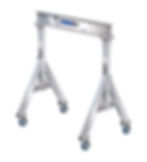Gantry Crane
Gantry Cranes are an ideal alternative in buildings which are unable to support an overhead crane.
They're also optimal for lifting and moving material and equipment located within limited spaces. Gantries consist of a crossbeam supported by vertical legs, designed to ride on casters or floor channels. Advantages include portability as well as easy assembly.
Frames can be provided in all steel or aluminum construction. Gantry cranes are also available in various capacities and with fixed or adjustable heights and spans.
Contact our Customer Service Department for more information regarding the different types of Gantry Cranes.

Gantry Crane Options
-
Made-To-Order 15 Ton Gantry Crane - Fixed Height, Steel Construction
-
Wallace Adjustable Height Workstation or Mighty-Mite Crane
-
Hippolift Steel Fixed-Height Portable Gantry Crane
-
Thrifty Gantry Crane
-
Tri-Adjustable Gantry Crane
-
Aluminum Gantry Crane
-
A-Series Gantry Crane
-
Single Leg Gantry Crane
-
PF-Series Gantry Crane
-
E-Series Gantry Crane
-
T-Series Gantry Crane
GANTRY CRANES PROVIDE GREATER FLEXIBILITY
A gantry is a metal framework that spans a set distance with supports reaching the ground on either side of the frame. Unlike jib cranes, the frame has a support structure on both sides of the span for maximum stability and weight ratings. They rest on the floor which means most don’t require overhead attaching, and smaller ones can be moved around as needed. There are three basic types of Jib Cranes:
-
Hand-push crane
-
Motorized crane
-
Semi gantry crane
HAND PUSH GANTRY CRANES ARE IDEAL FOR CHANGING WORK ENVIRONMENTS
Ranging from ½-ton to 10-tons, these cranes have heavy caster wheels for moving. They’re affordable, take up little space and can lift materials that are too heavy to handle manually. They’re also very safe since they straddle the hoisted item.
LARGER GANTRY CRANES REQUIRE MOTORS
Larger loads aren’t practical or safe for hand-push cranes. Motorized cranes substantially improve productivity and may use floor-mounted tracks for stability.
We have many pre-engineered, motorized cranes available. A motorized gantry crane often doesn’t require permanent changes. Just like our other products, we can tailor a gantry crane to fit your required needs.
SEMI GANTRY CRANES BRIDGE THE DIVIDE
Half gantry and half overhead crane, the semi gantry has one side resting on the floor while the other rides on an elevated runway. This combines the stability and space-saving of the overhead yet doesn’t require overhead installation on the other side.
They can also be installed below an overhead crane for added productivity and coverage. They’re always motorized and use a pendant or radio control. They require to be custom-built but can use some pre-engineered components.




